This ‘n’ that
Warmer climes
10 November 2011 | This 'n' that

Up and away: Jukka is about to leave for the south. Photo: Hannu Vainiopekka /Finnish Museum of Natural History
Jukka spent the night of 9 October by the river Sana in Bosnia-Herzegovina. He then crossed the Croatian border, at times reaching a speed of 96 kilometres per hour.
By 15 October Jukka had crossed the border between Libya and Niger; 350 kilometres later he settled in the desert for the night. After entering Cameroon on the 21st, Jukka completed his journey of 34 days and 6,600 kilometres by landing on the bank of River Benoue and taking a well-earned break. In March it will be time to head homewards again, to Lake Pälkäne in Finland.
Jukka is a Finnish osprey.
Earlier, another osprey, Lasse, surprised the zoologists by spending his winter in Israel, instead of Africa. But Harri decided to wing his way as far as to South Africa, almost 12,000 kilometres from home, a distance he covered in some 57 days!
The Finnish Museum of Natural History / University of Helsinki and the Finnish Osprey Foundation track ospreys with the help of satellite tracking.
Long-distance travelling is dangerous, though: Eikka perished on his way to the south in Ukraine this autumn, and in 2008 Pete was probably eaten by a local eagle in Morocco: some of his feathers, as well as the transmitter were found beside a river by two officials of the Emirates Center for Wildlife Propagation, Eric Le Nuz and Rachid Khain.
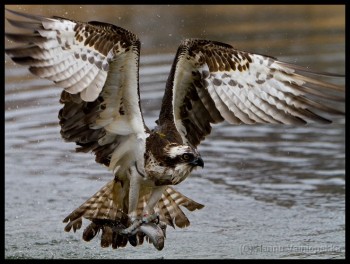
Gone fishing: Jukka the satellite osprey having lunch. Photo: Hannu Vainiopekka/Finnish Museum of Natural History
And why this interest in wildlife, you might wonder? Oh, as we sit here and edit Books from Finland in the semi-darkness of a November afternoon, creatures that migrate just seem to come to mind. Not to mention hibernation, but that’s another matter….
Where’s life best for women?
14 October 2011 | This 'n' that
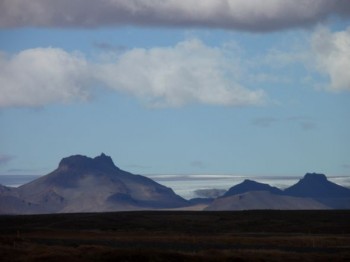
Ice, lava & quality life for women: Iceland. Photo: Soila Lehtonen
In Iceland.
The Daily Beast – the online home of Newsweek Magazine – has compiled the rankings of the best and worst countries for women to live in. 165 countries were analysed by using five factors – justice, health, education, economics and politics – and awarding scores of 0 to 100.
Each category included between four and ten data points, depending on the reliable data points available. The results, published last month, show that for a woman Iceland is the best place: overall score was 100.0. Second was Sweden (99.2), third Canada (96.6), fourth Denmark (95.3) and fifth Finland (92.8). The next five were Switzerland, Norway, USA, Australia and the Netherlands.
The final ranking is based on how much better or worse a country is for women when measured against the average level of women’s rights for all 165 countries – of which the worst three are Yemen, Afghanistan and Chad.
Some progress seems to have been going on in the world lately; in politics women have become more visible. They will now even be allowed to vote in Saudi Arabia. (But there women are still not able to leave the country or work without a permission from a male relative – or drive a car.)
Iceland’s current prime minister is Johanna Sigurdardottir; the country’s score points for politics is 92.8, whereas Finland’s is 100.0.
However, justice and economics do not score as high in Finland as in Iceland. ‘Prevalence of intimate partner physical and sexual violence’ may cause the loss of points in the former case, and ‘women’s wages as a percentage of men’s’ in the latter.
Finland is the only country on the list with 100.0 points in politics: currently the president, 84 of the 200 members of the parliament and nine ministers out of 19 are women. So, it might be quite possible that women will make Finland climb up towards the top of the mountain – or rather, volcano?
Your heart on your sleeve
7 October 2011 | This 'n' that
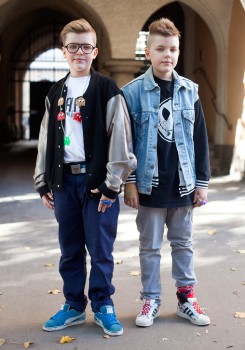
Street cred of Hel Looks: Josua and Julius. Photo: Sampo Karjalainen
The founder of Hel Looks, which charts clothing styles of Helsinki denizens (which we featured here on the Books from Finland website), has been talking to Finnish television (programme in Finnish) about her website.
Established in 2005, the site – which has an eye for the weird and wonderful rather than the classically stylish – attracts an average of 10,000 visitors a day, two thirds of them from outside Finland.
Fashion editor Liisa Jokinen says she got the idea for the site while on holiday in Sweden. ‘I think a lot of Finns admire the Swedes’ fashion sense and in particular their stylishness. But in fact the range of styles is greater in Helsinki, and Finns have the courage to be different,’ she says.
Recent images from the site bear her comments out, and chart the sheer range of costume that she and the photographer Sampo Karjalainen set out to document. Take the 13-year-old fashionistas Josua and Julius (left), snapped on Bulevardi in central Helsinki on 1 October, for example: ‘We dance hip hop and house. It inspires our style. We try not to dress up like all other boys’; or Noel Coward fan Janne, 51, seen on 3 September: ‘I’m wearing an English tweed suit tailor-made in London. I live in Mexico, where I normally wear a white linen suit.’
Best of all, says Jokinen, is when she comes across someone for a second time without realising that she took their picture a year or so back. The image of Helsinki reflected by Hel Looks is made up of people, not buildings. ‘I believe people and their clothes contribute much more to a city than its buildings do,’ Jokinen says.
The photos on the Hel Looks site, currently numbering some 1,200, offer us visions of how people want to be seen; in this selection, few dress to play a role. People wear what they think is fun or/and stylish, and we, the onlookers, enjoy being the judges of this city catwalk.
The sound of music
2 September 2011 | This 'n' that
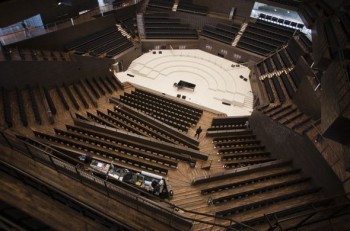
Helsinki Music Centre: the main hall. Photo: Arno Chapelle
The long-awaited new concert hall, Musiikkitalo (’Music house’, in English Helsinki Music Centre), in front of the Parliament house in the very heart of the city, was opened with a concert (this concert is available at YLE Areena until 30 September) featuring Sibelius and Stravinsky on 31 August.
Musiikkitalo finally provides a new home for two orchestras, the Helsinki Philharmonic Orchestra and the Finnish Radio Symphony Orchestra, as well as for the only Finnish university of music, the Sibelius Academy. It is owned by the Finnish government, the City of Helsinki and Finnish Broadcasting Company. The costs of the building rose from an original estimate of 98 million € in 2005 to 190 million €.
The acoustics designer is the renowned Japanese specialist Yasuhisa Toyota. The building, containing seven halls of various sizes, will provide specialised surroundings for different kinds of music and musicians, acoustics in the existing Finlandia Hall (designed by Alvar Aalto) and other local venues long having proved inadequate or faulty.
The site has remained misused for decades: the brick warehouses, dating from the late 19th and early 20th centuries, were finally abandoned by the national railway company in the 1980s and subsequently occupied by various artists’ and civil organisations, housing popular restaurants and flea markets. Many protests took place when the warehouses were doomed to demolition – and then the buildings were finally destroyed in 2006 in a fire.
The brand new concert hall in Reykjavik, Iceland, is called Harpa (‘Harp’). Wouldn’t it have been nice to give also Musiikkitalo a more exciting name to go by – maybe conduct a straw poll among listeners? Some of the rows of seats (1,704 in all) in the main hall resemble logs floating down in a river, so what about Log jam? Or does that have unfortunate connotations for a project that’s meant to provide Finnish music with a new dynamism?
Best in show
30 June 2011 | This 'n' that
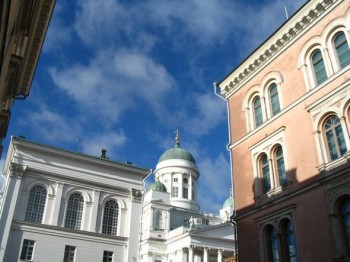
Cooler than we thought: Helsinki. Photo: Leena Lahti
So Helsinki has just come out top in Monocle magazine’s Quality of Life survey.
Monocle, which takes a determinedly internationalist and unfailingly style-conscious view of politics, business, culture and design, was founded by its editor Tyler Brûlé in 2007. As anyone who follows his weekly column in the Financial Times will know, Brûlé leads a peripatetic life that will have given him personal experience of most, if not all, of the 25 cities under Monocle’s lens in this survey.
Monocle’s preferences, as the top three cities on the list indicate – Helsinki is followed by Zurich and Copenhagen – is for small, well organised, forward-looking cities. Oh, and ones with good water pressure – his home town of London, which might otherwise have featured higher on the list, was debarred by its Victorian water system, which rules out the cheering experience of an energising shower before work in the morning.
So, on a list clearly based on the minutest of scrutiny, just what is it that makes life in Helsinki so different, so appealing?
According to the criteria used, ‘the world’s most liveable city’ boasts a low crime rate, good school system, excellent public transport and low unemployment – but where Helsinki really stands out, for Monocle, is in its continuous implementation of intelligent urban planning (large docklands in the city centre have been demolished, for example, and replaced by desirable new housing areas) and its dynamic, can-do, approach to doing business.
Oh, and the eating and food culture in the city is flourishing, as the ‘New Nordic Cuisine’ rules. And, Monocle being Monocle, the sheer physical beauty of the city will have played its part in earning it its accolade. More details are to be found in the current, July-August, issue of Monocle.
Much of this is certainly true. From a resident’s point of view, Helsinki’s street culture has been transformed in the past fifteen to twenty years. The transportation system is a delight, although one that Helsinki people tend to take for granted, with clean buses, trains and trams running, broadly speaking, on time, as is the education system, with the state providing excellent schools to the extent that private-sector education is practically non-existent.
As for what the ‘New Nordic Cuisine’ is exactly, this remains slightly elusive to your editors here at Books from Finland, although it clearly has to do with well-sourced, locally grown food and simple flavours. We do agree that the demise of the less-hip beer-drinking dens of yesteryear and the rise of well-lit cafés and restaurant with pleasant outdoor seating are indeed reality. Old greasy spoons are on the wane, definitely.
Oh yes: and there’s nothing wrong with Helsinki’s water pressure. Our morning showers are decidedly brisk and invigorating.
Oink oink
23 June 2011 | This 'n' that
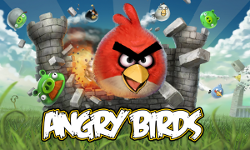 Naturally, here at Books from Finland, we’re keen to use the internet for serious (or not so serious) reading, but at the other end of the scale Finns are garnering considerable success in the world of smartphone games.
Naturally, here at Books from Finland, we’re keen to use the internet for serious (or not so serious) reading, but at the other end of the scale Finns are garnering considerable success in the world of smartphone games.
We don’t like to blow our collective trumpets, but it’s a little-known fact that the phone game Angry Birds, with birds and pigs in the starring roles, is actually Finnish, developed in 2009 by a company called Rovio. As the Helsinki freesheet Metro (31 May) notes, Angry Birds has been downloaded more than 200 million times on different devices since its launch in December 2009.
What is the secret of Angry Birds’ success? ‘I like it because it doesn’t really have any rules and you never know exactly what’s going to happen next,’ says our young reviewer Sophia, 9; her sister, Tia, 5, says ‘I like it because you get to shoot in it.’ To judge by the amount of time they spend playing Angry Birds, they like it a lot.
And how did Angry Birds come about? ‘At the beginning of 2009 our design group went through a number of different options,’ Rovio’s communications director Ville Heijari tells Metro. ‘One of them was angry-looking birds, and everyone fell in love with them right away.’ And what does Heijari himself like best about the game? ‘Definitely the fact that when you make a mistake, the pig laughs at you. That really makes you want to try again.’
In the pipeline is an Angry Birds movie, plus further development of the game itself. ‘So far the world has only seen an glimpse of the birds’ world,’ says Heijari.
By the way…
23 June 2011 | This 'n' that
To get Books from Finland delivered to you by e-mail, just click here and follow the instructions.
Coming up…
23 June 2011 | This 'n' that
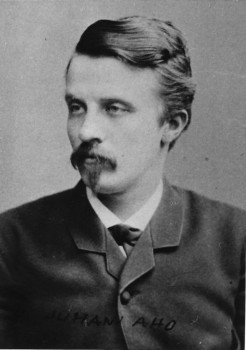
Juhani Aho. Photo: SKS/Literary archives
After having read Juhani Aho’s sensual novella Yksin (‘Alone’, 1890), set in Paris, composer Jean Sibelius threatened to challenge its author to a duel.
The yearned-for loved one in the novella resembled Sibelius’s fiancée Aino Järnefelt, for whom author and journalist Aho had nursed an unrequited passion. (No duel ensued after all.)
This year marks the 150th year since Aho’s birth. An early modernist, Aho (1861–1921) was a versatile writer whose narrative skills have made him a classic. We shall feature extracts from Yksin – in Herbert Lomas’s translation, first published in Books from Finland in 2006 – along with a reappraisal of Aho’s work in the early years of the 20th century by Professor Jyrki Nummi.
What do YOU think?
8 April 2011 | This 'n' that

Illustration: Joonas Väänänen
Dear Reader:
we would love to know what you think about Books from Finland and what it means to you.
You can of course always send us suggestions and comments – interactivity is one of the great bonuses of being online – but we’d like to ask you some specific questions so that we can build up a picture of who reads our website, as well as your likes and dislikes.
We’ll start now, posting a question each month – see the sidebar on our main page. Please participate!
The Editors
National treasures
7 April 2011 | This 'n' that
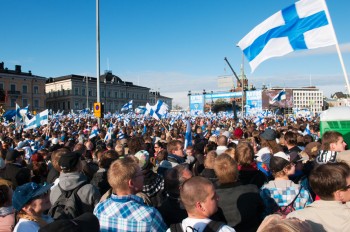
The name of the game: ice hockey. Photo: Jaakko Oksa
In Japan, artists or craftsmen of the highest quality may be honoured with the title ‘Living National Treasure’. In Finland, it seems only ice hockey players are eligible for that title, if you ask the man on the street, as ice hockey seems to be Finland’s ‘national’ sport.
(For example another ice team sport, synchronised skating, doesn’t compete in the same national treasure series, despite the fact that the Finnish team won the gold – again – in the World Championships in April. [Finland has won gold six times, Sweden five.] No national flag-waving resulted. But of course they are just women, who don’t win sports wars against other nations.)
On Sunday, 15 May, a dream came true at last, as Finland won the gold medal at the Ice Hockey World Tournament. And what’s more, it was Sweden – neighbour and old colonial overlord – they beat (6–1).
As the victorious team, escorted by a Hornet fighter from the Finnish air force, returned from Bratislava to Helsinki on Monday night, some 100,000 people crowded the capital’s Market Square to celebrate. The team and a selection of pop musicians climbed up on a stage to start the party – and President Tarja Halonen also popped in, from her presidential palace by the Square, to congratulate.
When’s the last time when 100,000 Finns gathered anywhere? Perhaps in 1995, when Finland first won the same title? See the series of photographs on the Internet pages of the Swedish paper Aftonbladet, particularly a shot of Helsinki harbour taken with a fish-eye lens.
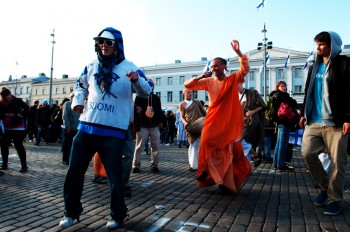
All together now! Photo: Jaakko Oksa
Sweden has been a much more successful hockey country than Finland, but it’s clearly tough to be a good loser. As the rivalry – in sports in particular – between Sweden and Finland is traditionally a larger-than-life issue, the Swedish newspapers and their readers displayed a highly amusing spectrum of opinions. ‘Kul att dom får fira något. Dom bor ju trots allt i Finland’ (‘Great that they have something to celebrate. After all, they live in Finland’), said one reader sourly.
And celebrate they did. One of the coaches stumbled and fell on his face on the red carpet on landing in Helsinki, and before you could say oops, he ended up on the YouTube accompanied by extracts from the final match television coverage by the celebrity sports commentator Antero Mertaranta.
Sportsmen and -women are supposed to be positive role models for young people, but as some of the team members clearly seemed to enjoy something stronger than sports drinks on the Market Square, they have been reproached for this behaviour by many people – spoilsports?
The coach of the Finnish national team, Jukka Jalonen, said in an interview that he could not condemn the use of alcohol in celebrating a ‘rare achievement’ like this, as ‘children and young people surely understand that adults may sometimes get drunk. Many of them have seen their parents sloshed.’
Well, if we assume it’s OK to be drunk in front of your children, it is no wonder that younger and younger children start drinking – which, however, is not considered OK, not by anyone. Can someone explain this?
Self-made life
2 April 2011 | This 'n' that
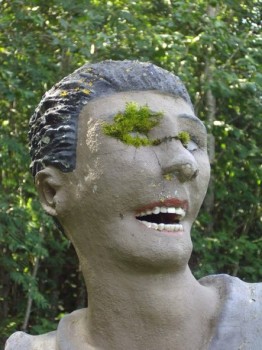
Art & nature: one of Veijo Rönkkönen's sculptures. Photo: Soila Lehtonen
You may perhaps remember an article entitled Self-made man, published on these pages in 2009: the sculptor Veijo Rönkkönen lived on a small, isolated farm in Parikkala, eastern Finland, where he spent his spare time building a garden of five hundred figures of concrete.
He lived in a cottage in the middle of his garden. Rönkkönen died a year ago, at the age of 66, and the future of his park, open and free to all, was unsolved for a while, as the Parikkala authorities were not willing to foot the bill for the upkeep the place – despite the fact that more than 25,000 people visit the park each year.
Now, the problem of the upkeep of the statue park, a ‘total work of art’, has been solved, as a businessman has bought the garden from Rönkkönen’s estate. and a number of institutions and individuals, among them friends of art and voluntary workers, have pledged keep the park open to visitors.
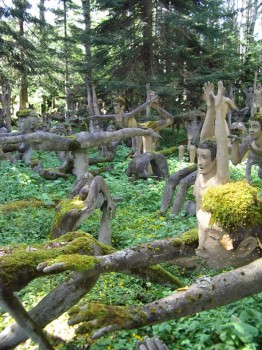
Yoga bare: Veijo Rönkkönen himself practised yoga. Photo: Soila Lehtonen
Photographer and writer Veli Granö introduced the life and works of this self-made artist in his book Veijo Rönkkösen todellinen elämä / The real life of Veijo Rönkkönen (Maahenki, 2007). Contemporary folk art goes by the acronym ITE, from the words itse tehty elämä, ‘self-made life’. The English-language term is ‘outsider art’.
The future of Rönkkönen’s cottage is undecided: it may become a park-keeper’s residence, or be used as an artist’s residence. Around it, the extraordinary legacy of this self-made artist – hundreds of statues, human and animal figures – will keep growing lichen and moss, ageing naturally.
From the land of abundant reindeer…
17 March 2011 | This 'n' that
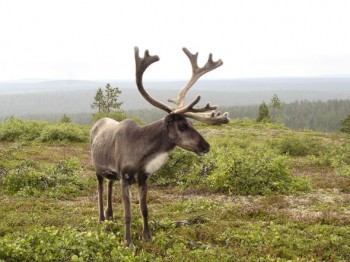
Rangifer tarandus, Finnish Lapland. Photo: Grand-duc (http://en.wikipedia.org/wiki/User:Grand-Duc)
Is Finland, a land of reindeer, ‘dense pine forests and deep snows’ also a ‘quiet literary landscape’?
Not exactly, as we at Books from Finland hope we are demonstrating. And over on the Bookslut website, Bonnie B. Lee comes to the same conclusion, after having mused about the reindeer (yes: in Helsinki you find tasty chunks of them in the freezer boxes of any foodstore) and reading three Finnish novels in English translation.
The novels Lee reviews are Purge by Sofi Oksanen (Puhdistus, 2008, translated by Lola Rogers, published last year), When I forgot by Elina Hirvonen (Että hän muistaisi saman, 2005, translated by Douglas Robinson, published in 2009) and The Year of the Hare by Arto Paasilinna (Jäniksen vuosi, 1975, first published in an English translation by Herbert Lomas in 1995, reprinted as a Penguin edition last year).
We have just entered the Year of the Rabbit, in recognition of which Paasilinna’s book (about a man who rejects his old life and goes roaming the wildernesses with a hare as his only companion) has appeared on the tables of large bookstores in the US. ‘The Year of the Hare is only the most Finnish, and perhaps most antically Zen-ish, of a shelf-load of books that tell us to find and live by our own ideas of contentment,’ said The Wall Street Journal.
The traumatic experiences of war and Finland’s deep forests are the common feature of these novels, Bonnie B. Lee finds. She also opines that ‘melancholy pervades the Finnish psyche’, and that ‘Finland vies with Hungary for highest suicide rate in Europe‘. Oh, but this latter is no longer true: number one on a World Health Organisation suicide rates list is Lithuania, followed by Hungary, Slovenia, Estonia and Latvia – Finland is number six.
Lee is clearly intrigued by her travels in contemporary Finnish literature. ‘The search for identity, a reckoning with a troubled past, and an outsider’s view looking in,’ she comments, ‘are all the stuff of great writing, and Finland is poised to continue to produce poignant and introspective literature that we can appreciate now that English translators have begun the work.’
Poignant and introspective or occasionally funny and fantastical, this is the work we try to offer an early glimpse of, in translation, at Books from Finland. Stay with us!
Is it a play, is it a book?
25 February 2011 | This 'n' that
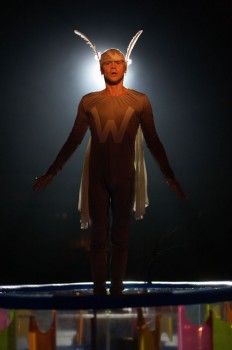
On the way to fame: Walt the Wonder Boy in Kristian Smeds's stage adaptation of Paul Auster's novel Mr. Vertigo at the Finnish National Theatre (2010). Photo: Antti Ahonen
Dramatisations of novels are tricky. Finnish theatremakers like adapting novels for the stage, which often results in a lot of talking instead of action – and action here doesn’t refer to just physical movement but to the subtext, to what happens under and behind the words.
Currently an adaptation of an American novel is running on the main stage of the Finnish National Theatre in Helsinki. Mr Vertigo (1994), Paul Auster’s seventh book, tells the story of an orphan boy in the 1930s St Louis. After harsh years as the long-suffering apprentice of the mysterious Master Yehudi, Walt becomes the sensational Wonder Boy by learning how to levitate.
In theatremaker Kristian Smeds’s adaptation, Auster’s whimsical, rambling novel becomes a capricious, illusory journey about illusions, freedom, and the unattainability of love. Walt (the highly expressive, athletic Tero Jartti) interprets, with hilarious comedy as well as with touching desperation, both the dizzyingly powerful experience of creativity and the ridiculous hubris of the artist. More…
Serious comics: Angoulême 2011
24 February 2011 | This 'n' that

Graphic artist Milla Paloniemi went to Angoulême, too: read more through the link (Milla Paloniemi) in the text below
As a little girl in Paris, I dreamed of going to the Angoulême comics festival – Corto Maltese and Mike Blueberry were my heroes, and I liked to imagine meeting them in person.
20 years later, my wish came true – I went to the festival to present Finnish comics to a French audience! I was an intern at FILI – Finnish Literature Exchange, and for the first time, FILI had its own stand at Angoulême in January 2011.
Finnish comics have become popular abroad in recent years, which is particularly apparent in the young artists’ reception by readers in Europe. Angoulême isn’t just a comics Mecca for Europeans, however: there were admirers of Matti Hagelberg, Marko Turunen and Tommi Musturi from as far away as Japan and Korea.
The festival provides opportunities to present both general ‘official’ comics, ‘out-of-the-ordinary’ and unusual works. The atmosphere at the festival is much wilder than at a traditional book fair: for four days the city is filled with publishers, readers, enthusiasts, artists, and even musicians. People meet in the evenings at le Chat Noir bar to discuss the day’s finds, sketching their friends and the day’s events.
As one Belgian publisher told me, ‘There have always been Finns at Angoulême.’ Staff from comics publisher Kutikuti and many others have been making the rounds at Angoulême for years, walking through the city and festival grounds, carrying their backpacks loaded with books. They have been the forerunners to whom we are grateful, and we hope that our collaboration with them deepens in the future.
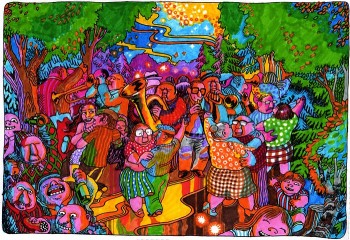
Aapo Rapi: Meti (Kutikuti, 2010)
This year two Finnish artists, Aapo Rapi and Ville Ranta were nominated for the Sélection Officielle prize, which gave them wider recognition. Rapi’s Meti is a colourful graphic novel inspired by his own grandmother Meti [see the picture right: the old lady with square glasses].
Hannu Lukkarinen and Juha Ruusuvuori were also favorites, as all the available copies of Les Ossements de Saint Henrik, the French translation of their adventures of Nicholas Grisefoth, sold out. There were also fans of women comics artists, searching feverishly for works by such artists as Jenni Rope and Milla Paloniemi.
Chatting with French publishers and readers, it became clear that Finnish comics are interesting for their freshness and freedom. Finnish artists dare to try every kind of technique and they don’t get bogged down in questions of genre. They said so themselves at the festival’s public event. According to Ville Ranta, the commercial aspect isn’t the most important thing, because comics are still a marginalised art in Finland. Aapo Rapi claimed that ‘the first thing is to express my own ideas, for myself and a couple of friends, then I look to see if it might interest other people.’
Hannu Lukkarinen emphasised that it’s hard to distribute Finnish-language comics to the larger world: for that you need a no-nonsense agent like Kirsi Kinnunen, who has lived in France for a long time doing publicity and translation work. Finnish publishers haven’t yet shown much interest in marketing comics, but that may change in the future.
These Finnish artists, many of them also publishers, were happy at Angoulême. Happy enough, no doubt, to last them until next year!
Translated by Lola Rogers
The naked truth
18 January 2011 | This 'n' that
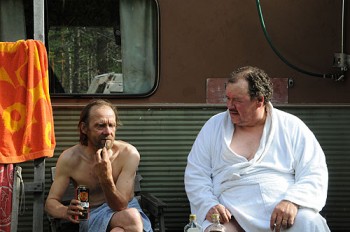
Out with the truth: sauna camaraderie in the film Steam of Life. Photo: Oktober
Finnish men don’t usually open up about much, it’s generally thought, as they don’t like to speak about feelings.
But in the sauna, it’s different. Intimacies are revealed in its soft steam, by men who sit there quietly and give voice to the sorrows of their lives.
In Miesten vuoro / Steam of Life, a full-length documentary film by two directors, Joonas Berghäll and Mika Hotakainen which premiered in March 2010, Finnish men both talk and weep. They have gained considerable popularity among audiences in Finland and abroad.
A naked guy sits on a wooden bench in the steam or outside the sauna building (which could be an old wooden hut in the countryside, a modern city sauna or some odd construction serving the purpose) with a bottle of beer in his hand, and tells the man sitting next to him in earnest about his dead child, new wife, or the death of his mother: the great sorrows or joys of his life.
Water, fire, bare skin and no ornaments: vulnerability. He can be a war veteran or a younger man, lonely or happily married. But he talks, cleansing himself both physically and mentally.
Steam of Life has so far been seen by approximately 50,000 people in Finland, and the DVD has sold more than 28,000 copies. It is the first Finnish documentary to compete for the Academy Award for Best Foreign Language Film. The Oscar nominees will be published on 25 January, with the award ceremony taking place at the end of February.
Steam of Life has won prizes both in Finland and abroad: in Tel Aviv, Warsaw, Pärnu in Estonia, Germany (DOK Leipzig where it won a Silver Dove) and Portugal. It received a Special Jury Mention at the Silverdocs documentary film festival in the United Sates and the Prize of the Interreligious Jury at the Visions du Réel festival in Switzerland. It will continue its tour of film festivals this year; see the trailer here.
The DOK Leipzig jury commented: ‘The film, deliberately set in an original Finnish situation – a sauna, opens a door into the intimate and hidden world of men’s fragility and vulnerability, turning the sauna into a place where naked truth is told by naked men. The film bends together tragic and comic….’
Mies ei puhu eikä pussaa is a saying; we’d translate this as ‘a Finn neither speaks nor snogs’, Finn referring to a male person. But the times, they are a-changing, it seems.
